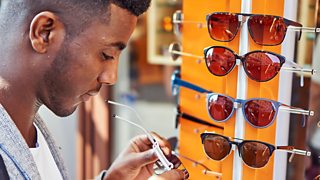How did e-cigarettes and vaping get so popular?
The global market for vapes has grown exponentially over the last decade. It's now estimated to be worth around £20 billion a year, up from just over £2.5 million in 2016.
In the UK there are now around 4.5 million regular vapers, served by nearly 3,000 specialist vape stores and a growing number of online retailers. But vapes are now available almost everywhere, from supermarkets to corner shops.
All Consuming is the Radio 4 series in which Charlotte Williams and Amit Katwala explore our habits of consumption through products and services that have changed the world. They attempt to demystify the world of e-cigarettes and vapes, tracing their history and extraordinary growth and asking, are they lifesavers or something far more insidious?
The origins of e-cigarettes can be traced back almost a century
From ads on buses to the branding plastered over your local newsagent, vapes are suddenly everywhere. And although the explosion in demand is relatively recent, their origin can actually be traced back almost 100 years.
In 1927, New Yorker Joseph Robinson filed a patent for a device he called a 'mechanical butane ignition vaporiser'. It was designed as a medical tool, to enable people to inhale medicinal compounds. But although it's generally regarded as the first electric vaporiser, it never really left the drawing board.
The next stage in the evolution of the e-cigarette came in 1963 when another American, Herbert A Gilbert, came up with a smokeless non-tobacco cigarette. Like its modern equivalent, it used a battery to heat flavoured vapour. But it didn't catch on. People weren't yet aware of the dangers of smoking tobacco, and weren't really looking for an alternative.
Then in the late 1970s, Phil Ray and Norman Jacobson took things a step further: a filter soaked in nicotine which you would inhale every time you sucked on it. The pair are credited with popularising the term 'vape'.

The first commercial e-cigarette was invented by a smoker who wanted to quit
The big step forward in e-cigarette technology came much later.
Chinese pharmacist Hon Lik came up with the idea of an e-cigarette in 2001. It was a way for him to cure his own smoking addiction following the death of his father from lung cancer.
"I worked hard to invent the e-cigarette," said Hon in an interview on Newsnight. "I saw the future business for them but I knew it would change many people's habits and many people could benefit as well."
Though modern vapes have come a long way since, Hon's basic concept of mimicking smoking by vaporising nicotine liquid remains the same.
Vaping is actively promoted as a smoking alternative by Public Health England
E-cigarettes are banned in some countries, including Argentina, Hong Kong and India, where the authorities cited a potential smoking epidemic in the younger population.
Health authorities in the UK are actively courting the vape industry in an effort to cut smoking rates.
But in the UK, it's a very different story. Health authorities here are actively courting the vape industry in an effort to cut smoking rates, thereby contributing to the rise in vaping. One official information video from Public Health England advertises how "smokers who use e-cigarettes and get support from their local Stop Smoking service, have the highest quit rates".
Shaun Yendalls, the owner of two specialist vape shops in south London, explains how he was approached by the health service about collaborating: "The Lewisham NHS came to us about six months ago and they wanted to run a pilot scheme to get people away from smoking, so we said we'd happily partner up with them." Together, they set up a scheme where the patient is given a £25 voucher to spend on vaping products in store.
According to the charity ASH (Action on Smoking and Health), there are an estimated 4.3 million vapers in the UK and about 2.4 million of these are ex-smokers.

Why is the NHS encouraging smokers to take up vaping?
Health authorities in the UK are taking a different approach to the rest of the world.
The number of 11 to 15-year-olds vaping is on the rise
We know there's been a big rise in younger people vaping. A recent survey from NHS Digital showed that 9% of 11 to 15-year-olds say they are vapers. This is up from 6%, four years ago.
John Dunne, director general of the UK Vaping Industry Association, says: "The products are not designed for people who don't currently smoke." The official line is that they're designed to help people quit smoking. However, many would argue the colourful, pocket-sized technology – and flavours like butterscotch, marshmallow and cotton candy – are designed to directly target teens and young people. On top of this, the disposable vape makes a vaping habit much more affordable and accessible for children.
There are so many kids who think vaping looks cool, argues Charlotte. Whereas smoking is considered quite 'old school', a vape is a bit of kit, a product, a piece of technology that you can carry around with you. There are flavours, different colours, disposable ones, big ones. It’s 'exciting' and seen by lots of young people as 'a new toy'.
The vaping industry may claim the aim is to help people quit smoking, but nicotine gum or patches have never been advertised as universally as e-cigarettes. Vaping has "gone beyond its initial purpose, in a very convenient way for the tobacco companies that fund a lot of these vaping companies," says Amit. Notably, e-cigarette firm Juul – which is part-owned by tobacco giant Altria – recently paid out over $430 million after being accused of targeting teenagers with its advertising.
E-cigarettes may be healthier than smoking but remain highly addictive
Lots of ex-smokers swear that vaping has helped them to quit, and this has to be a good thing. "We already know that the products, if you compare them to smoking, are far safer to use," says John Dunne. "And, in fact, Public Health England has looked at the evidence and has concluded that the products are at least 95% less harmful."
However, none of us know the long-term health effects of vaping. And vape shop owner Shaun is concerned that many people still underestimate just how addictive nicotine is. He gets a lot of people in their early 20s, who have never smoked before, coming in for vapes. (According to ASH, 350,000 vapers have never smoked a cigarette.)
"We actually, genuinely try to discourage them from buying," says Shaun. "We try to deter them, telling them it's one of the most addictive substances known to man."
One thing is certain, with popularity growing and sales rising, vaping is here to stay.
Find out more about Amit and Charlotte's adventures in the world of e-cigarettes and vapes by listening here.
The information contained in this article was correct at the time of broadcast on 29 September, 2022.

More articles from Radio 4
-
![]()
Can you feel drunk without drinking alcohol?
The past, present and future of non-alcoholic drinks.
-
![]()
Can cooking with an air fryer save you money?
Seven things to consider before investing in one.
-
![]()
Six things to know before buying running shoes
Greg Foot looks at whether it's worth upgraing your trainers.
-
![]()
Is it worth paying for expensive sunglasses?
Eight things to consider before splashing out on new shades.





